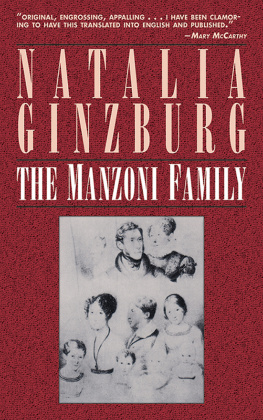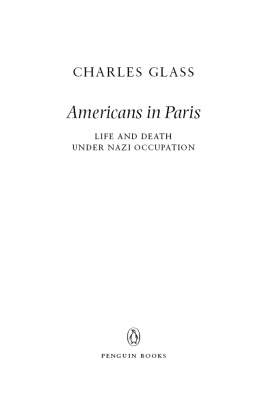
Praise for The Manzoni Family
[Ginzburg] re-creates the family life of Italys great 19th-century writer with an immediacy that grips even one who has read little or none of the work of Alessandro Manzoni.
The New York Times
The difference between this family saga and the ordinary family saga is the difference, say, between War and Peace and Dallas .
Boston Globe
Original, engrossing, appalling.
Mary McCarthy, bestselling author and literary critic
A glowing light of modern Italian literature.
The New York Times Book Review
As social history, with something of the flavor and immediacy of fiction, this story of a famous family stretching from 1762 to 1907 is interesting and well done. The book skillfully stitches together biographical facts and numerous family letters.
Publishers Weekly
Although Tolstoy maintained that happy families are all alike; every unhappy family is unhappy in its own way, contemporary readers of this work will identify with the illnesses of children, deaths of relatives, and all-too-frequent filial requests for money that confronted Italian literary giant Alessandro Manzoni, author of I Promessi sposi. Based on the familys voluminous correspondence, Ginzburgs portrayal is personal rather than literary, focusing on Manzoni family members; but a vivid picture of 18th- and 19th-century Italy and the literary scene in 19th-century Paris also emerges.
Library Journal
Italian novelist Ginzburg uses the epistolary technique to craft a brilliant biography of four generations of a complex, frequently tortured family an extraordinarily moving and evocative book.
Kirkus Reviews


Alessandro Manzoni
ALSO BY NATALIA GINZBURG
All Our Yesterdays
The City and the House
Family Sayings
The Little Virtues
The Road to the City
Voices of the Evening

1983, 1989, 1994, 2005 and 2013 Giulio Einaudi editore s.p.a., Torino English-language translation copyright 1987, 2013 by Marie Evans Foreword by Tim Parks copyright (c) 2019 by Skyhorse Publishing, Inc.
All Rights Reserved. No part of this book may be reproduced in any manner without the express written consent of the publisher, except in the case of brief excerpts in critical reviews or articles. All inquiries should be addressed to Arcade publishing, 307 West 36th Street, 11th Floor, New York, NY 10018.
Originally published in Italy under the title La famiglia Manzoni
This Arcade paperback edition 2019
Arcade Publishing books may be purchased in bulk at special discounts for sales promotion, corporate gifts, fund-raising, or educational purposes. Special editions can also be created to specifications. For details, contact the Special Sales Department, Arcade Publishing, 307 West 36th Street, 11th Floor, New York, NY 10018 or .
Arcade Publishing is a registered trademark of Skyhorse Publishing, Inc., a Delaware corporation.
Visit our website at www.arcadepub.com.
10 9 8 7 6 5 4 3 2 1
Library of Congress Cataloging-in-Publication Data is available on file.
ISBN: 978-1-62872-897-2
Printed in the United States of America
Contents

Foreword
Family Manzoni
T his book is a meeting between two authors who at first glance could hardly seem more different. Alessandro Manzoni (17851873) is simply the most celebrated figure in modern Italian literature. His great novel The Betrothed , published in quite different editions in 1827 and 1840, is the first modern novel in Italian, the later edition marking a milestone in the consolidation of Tuscan Italian as the language for a potentially united Italy. Profoundly Catholic in inspiration, the book was placed at the core of the Italian school syllabus after the country achieved unification in 1861 and still offers a linguistic and moral example to generation after generation of Italian children.
Natalia Ginzburg ne Levi (19161991), on the other hand, was a Jewish novelist and a Communist, whose husband Leone Ginzburg died in a Fascist prison during the Second World War. While Manzonis prose now seems elaborate, sometimes magniloquent, Ginzburgs was as spare, droll and laconic as Italian writing ever gets. While he narrated grandiose drama in one eight-hundred-page tome, she chronicled the intimacy of the humdrum in eight rather slender novels and novellas. He was a life-long phobic who suffered frequent panic attacks and found it impossible to leave the house without company and protection. She showed great courage and initiative during the War, saving her children and herself from the Nazi round-ups of the Jews in Rome after her husbands death. But perhaps most of all, Manzoni was a profoundly religious man whose faith is very much at the centre of his writing. Ginzburg was not religious at all and had nothing to say on the matter.
Why then this book? Perhaps the answer lies in the word family. All of Ginzburgs novels are very much about families, and all her characters take on their charm and identity insofar as they are seen in relation to others. Her most famous book, Family Sayings , is a lively study of her own family and circle of friends, in which everyone from the most illustrious to the most humble is given the same space, while she, the author, is barely present. It is rather as if she were telling us: if you want to know about me, you need to read about my family. All her work, she often observed, was in one way or other autobiographical, and many of her stubbornly awkward characters stand in relation to their families as she did to hers.
In the late 1970s, Ginzburg was commissioned to produce an anthology of Italian literature for use in schools. This inevitably brought her back to Manzoni. A friend persuaded her to read the many volumes of letters connected with the author and his extended family. Suddenly I understood how autobiographical The Betrothed was, Ginzburg remarked, how much he was like his many characters. At this point, both the great novel and the writer behind it became more interesting to her, made more sense; in short, Ginzburg was fascinated by this choral aspect of life, the way no one, and no work of art, stands alone.
Yet The Manzoni Family is not meant as an approach to Manzonis writing, nor do you need to know anything about The Betrothed to enjoy it. In 1973 Ginzburg had written an epistolary novel, Caro Michele , and would publish another, The City and the House in 1984, about which she said I see the world as if everyone were looking for a father they dont have and at the same time trying to be a father without managing to. This was exactly the story she found reading Alessandro Manzonis letters. Manzonis official father was nothing more than his mothers husband, and that only briefly. The real father was a lover who took no interest in the boy. Manzoni would spend his life attaching himself to older and illustrious friends, or to priests and spiritual advisers, father figures. At the same time he had nine children himself, and proved quite inadequate as a parent.
Next page













